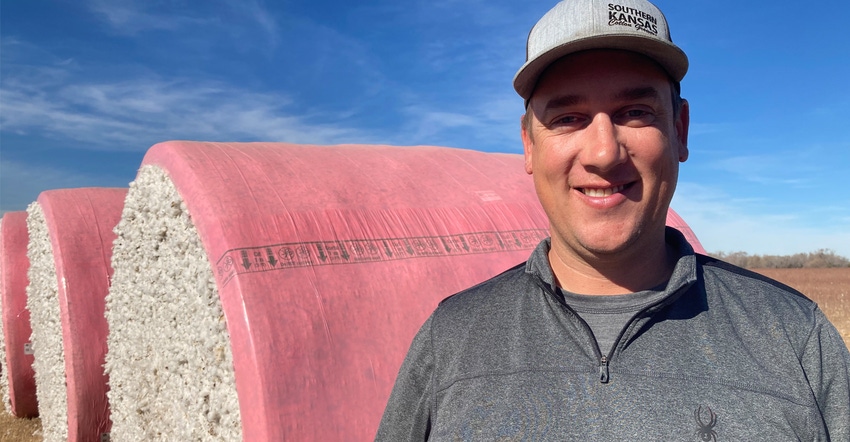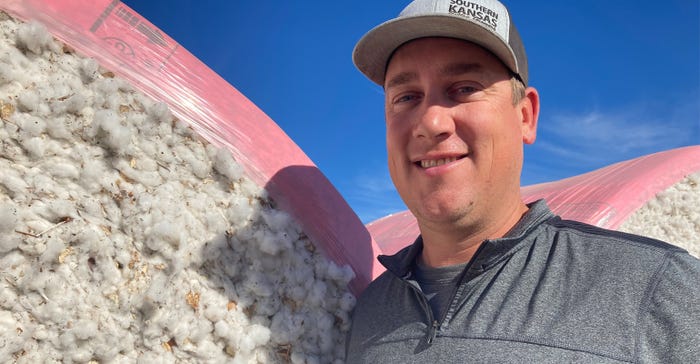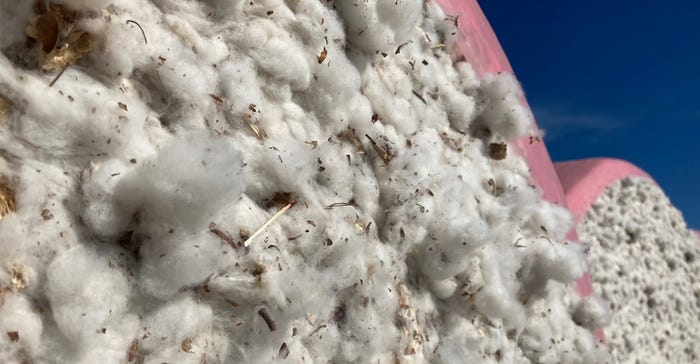
Making the decision to raise cotton wasn’t something that Ian Parker took lightly. But, after four seasons raising cotton on his family’s diversified farm near Mulvane, Kan., it’s turning out to be a good decision for his family and the land.
The Parker family has raised corn, soybeans and wheat near Mulvane for decades. Ian and his father, Larry Parker, watched neighbors start to raise cotton in south-central Kansas, but the equipment investment stopped them from following suit.
Parker says a steep drop in wheat prices opened their eyes to the opportunities growing cotton would bring them.
 DIALING IN: In four years, Ian Parker has learned a lot about raising cotton in south-central Kansas, but there’s more to learn every day. Still, cotton has already provided many benefits to the Parker farm.
DIALING IN: In four years, Ian Parker has learned a lot about raising cotton in south-central Kansas, but there’s more to learn every day. Still, cotton has already provided many benefits to the Parker farm.

“And, what really opened our eyes to cotton is, I have a landlord that has another tenant that grew cotton on [his land],” Parker says. So they tried it for that landlord. And the cotton outproduced their irrigated corn and dryland beans, and that was the “aha moment,” he adds.
Four years later, and the family’s crop rotation includes several hundred acres of cotton in the mix.
First steps
One of the biggest struggles Parker has had to overcome in learning to grow cotton is dialing in on planting the crop for their Kansas conditions. Parker says with a short planting window that’s right about the same time that their corn and soybeans are also going into the ground, it can get a little hectic.
“Cotton is so finicky on planting,” Parker says. “If it’s too shallow or too deep, it won’t emerge. It really needs good seed-to-soil contact.” For Parker, the answer was pushing his planting window earlier, into April, rather than the typical mid-May time frame. He can do that because he selects cotton varieties with ideal cold germination ratings.
He plants Nexgen 3406, 3930 and 3956 cottons, with dicamba tolerance. But they’re seeing damage from 2,4-D drift, Parker says, and so next year they’re going to switch to Enlist cotton to manage the problem.
“It’s been a hard decision, because these varieties have done so well for us — but it’s one of those things that we need to do for peace of mind,” he says.
The Parkers will begin harvesting cotton about October, and they’ll plant about two-thirds of their harvested cotton acres back to wheat if they have a timely harvest — sometimes pushing right up to the Nov. 15 planting date. This year, with warmer-than-normal weather, the cotton harvest was done by Dec. 1.
“Some of our best wheat is wheat that’s behind cotton,” Parker says. In some cases, wheat will put on extra tillers on previous cotton ground, he adds.
Soil health
Parker’s father, Larry, was an early adopter of yield monitors, and they have decades of data to help them build yield maps for their farm. Parker uses those maps for his zone soil sampling.
“So, we’ll set a field up with three or four zones, based off of yield — and we’ll go sample those zones, and then we’ll build variable-rate prescriptions for those zones,” he says. “We’ll put down just the fertility that those zones need, so we’re not overapplying fertilizer. We’re trying to be as efficient as we can with inputs.”
 PRETTY CROP: Cotton modules wait on the side of a field near Mulvane, Kan., for pickup by the Southern Kansas Cotton Growers gin.
PRETTY CROP: Cotton modules wait on the side of a field near Mulvane, Kan., for pickup by the Southern Kansas Cotton Growers gin.

Cotton’s long taproot is able to mine nutrients in the soil that corn and soybeans can’t quite reach, which is ideal for Parker’s marginal soils. Those acres used to be sorghum acres, until the sugarcane aphid made raising sorghum nearly impossible, he says.
“I do like the deep taproot[cotton has] to go get some of the nutrients that have leached through,” Parker says. “The only downside I don’t like about cotton is just the lack of residue left on the soil.”
Residue is important to Parker. The farm uses strip tillage and no-till, depending on the needs of the field and the crop being put in.
“So we will put anhydrous on, and then we’ll use MESZ [MicroEssentials SZ] for our phosphorus, and that’ll have zinc and sulfur in it,” Parker says. “And then we’ll put potassium in the strip, too.” Parker says soil tests show they also need to apply potassium, which cotton needs for fiber development.
Parker says the family also strives to have the fields planted to continuous crops. While they don’t use cover crops, their wheat acts somewhat like a cover crop, keeping a living plant in the soil so it reduces erosion.
“All our wheat is either planted behind corn, soybeans or cotton,” he says. “And so we just kind of tried to keep a continuous crop growing, to help protect the soil and create as much residue out there as we can.”
Dialing in
In four years, the Parkers have found what works for their farm and their cotton crops: from learning to not overwater cotton, to using plant growth regulators, to tweaking their fertility program and more. And they continue to dial in and make improvements.
For example, Parker says using cotton’s long taproot to mine fertilizer deeper in the ground that was left over from previous years of corn or wheat is one way they can back off applying as much nitrogen this year. While they have their anhydrous booked, they will plan to switch out about 500 acres of dryland corn with soybeans next year, and another couple hundred acres to cotton, because they’re not sure they’ll be able to source crop inputs in the spring.
“It’s scary right now because we talk to our suppliers — and they tell us they can’t get us a price because they have no price yet,” Parker says. “They’re trying their best, but it’s all to be determined.” So, until the supply chain situation resolves, cotton is one way they can mitigate the situation.
In the future, Parker would like to experiment with 60-inch cotton. While it could save the Parkers seed costs, there could also be a problem controlling weeds easily because of less canopy coverage.
Cotton is a profitable crop for the Parkers, but it’s also one that is the riskiest and takes the most attention.
And that’s the biggest piece of advice Parker can pass along to other farmers considering adding cotton into their crop rotations in Kansas.
“It’s not a crop to plant and forget,” he advises. “You have to be out every week, and scouting.” But if you’re willing to do that, you just might find this pretty crop has a place on your farm, too.
About the Author(s)
You May Also Like






